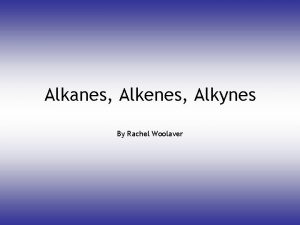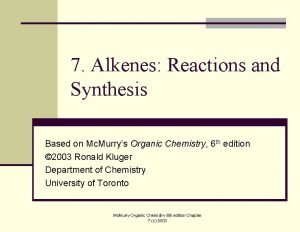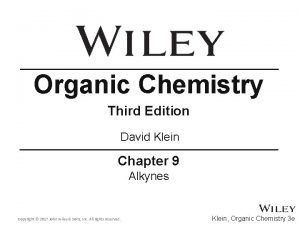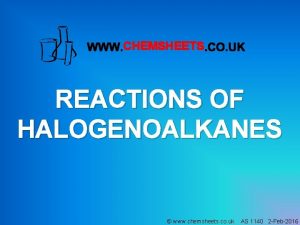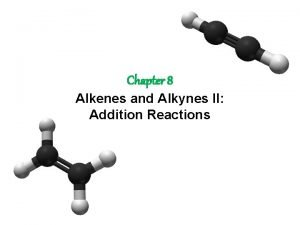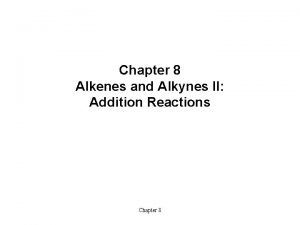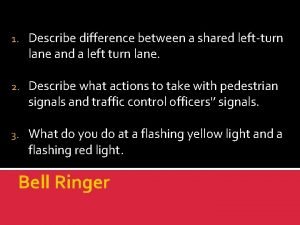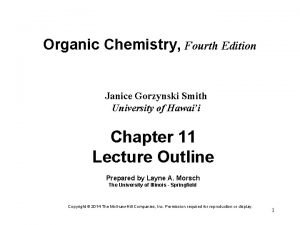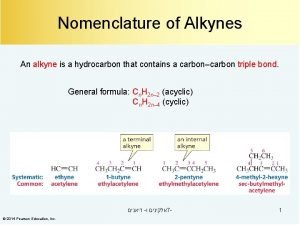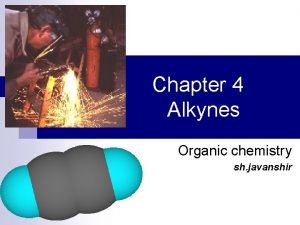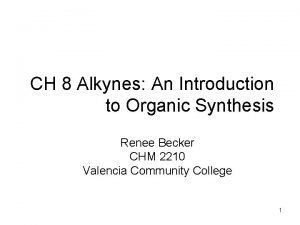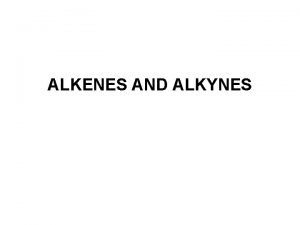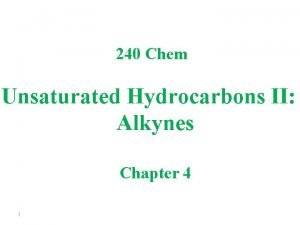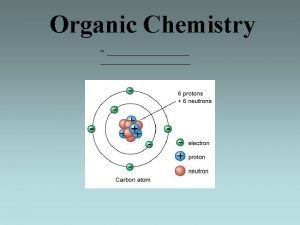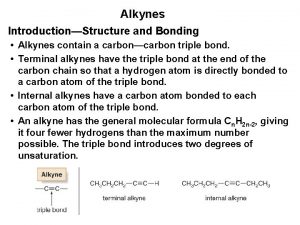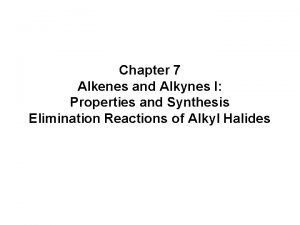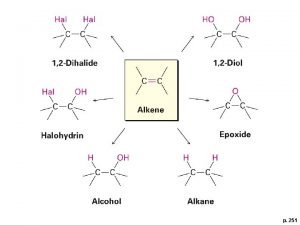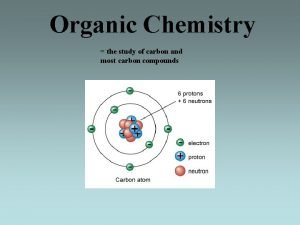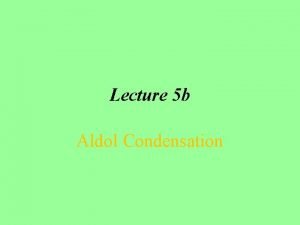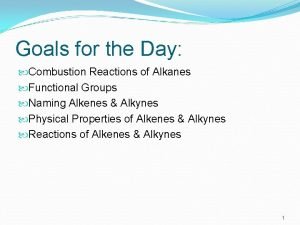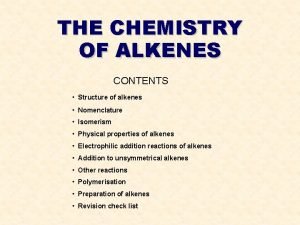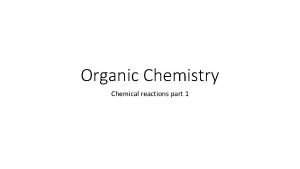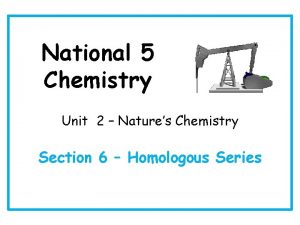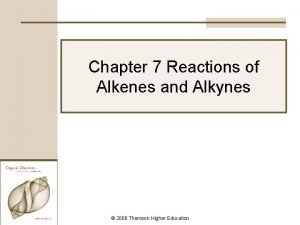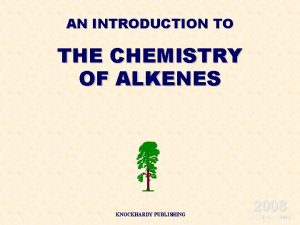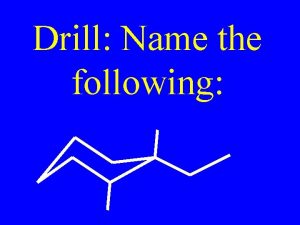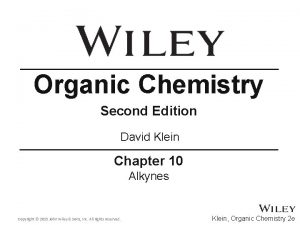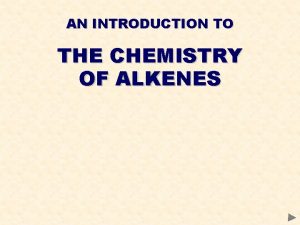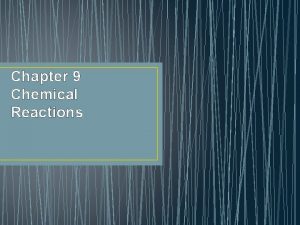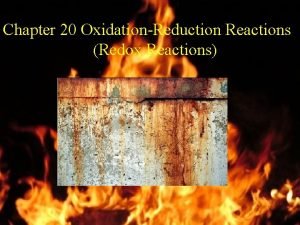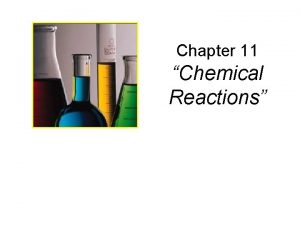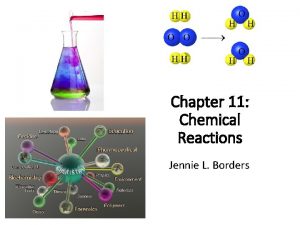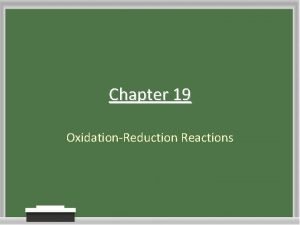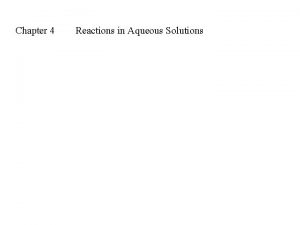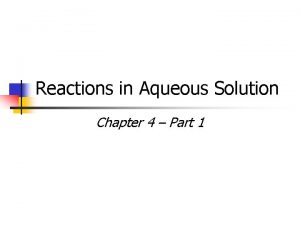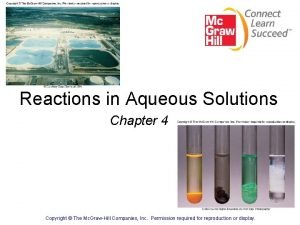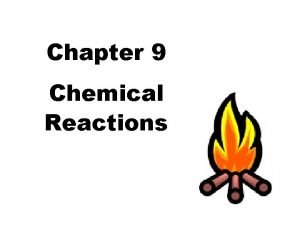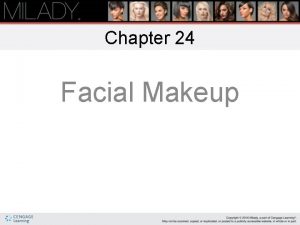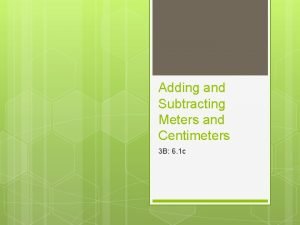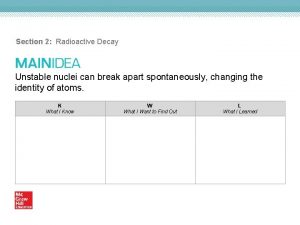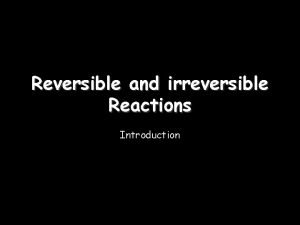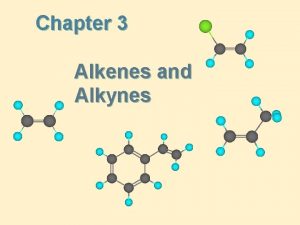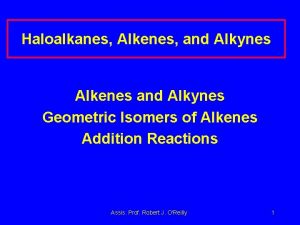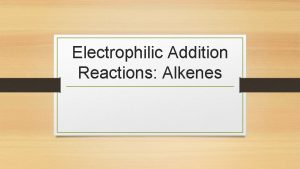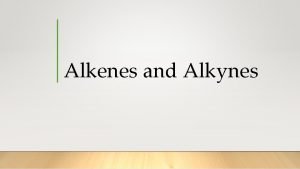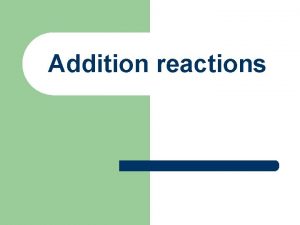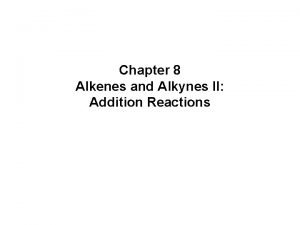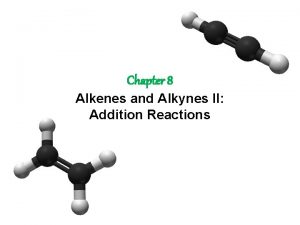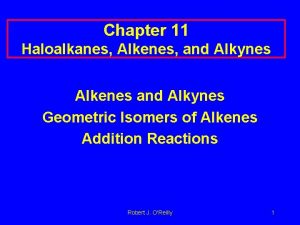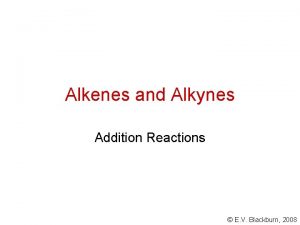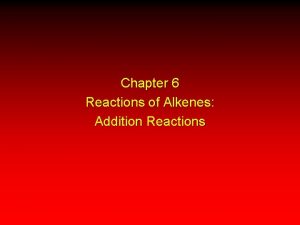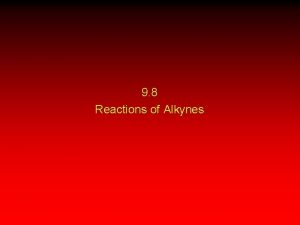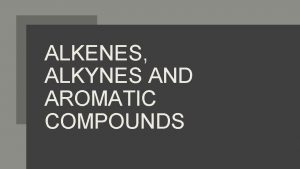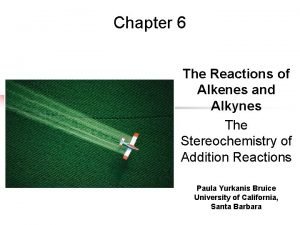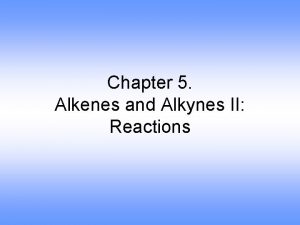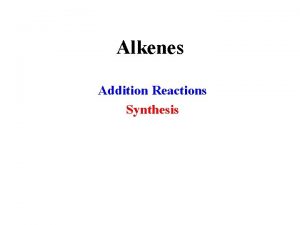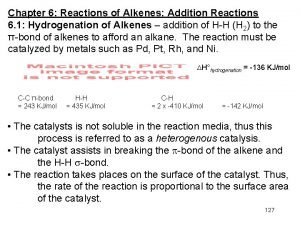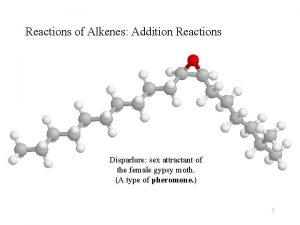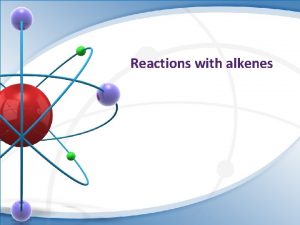Chapter Eight Alkenes and Alkynes I Addition Reactions





































































- Slides: 69

Chapter Eight Alkenes and Alkynes I. Addition Reactions WWU -- Chemistry

Types of Additions =>

Sect 8. 1: Addition Reactions WWU -- Chemistry

Addition of H-X WWU -- Chemistry

Addition of Water WWU -- Chemistry

Sect. 8. 2: Introduction to Mechanisms • • • mechanism two step rate determining step (i. e. slow step) energy diagram transition states intermediates WWU -- Chemistry

MECHANISM STEP-BY-STEP ACCOUNT OF WHAT HAPPENS : Xstep 1 C C + E E step 2 X C C E + Intermediate intermediates are formed during a reaction but are not products WWU -- Chemistry

ENERGY PROFILE two step reaction intermediate TS 1 E N E R G Y TS 2 - X C C + E step 1 C C E + step 2 DH product X C C E WWU -- Chemistry

ACTIVATED COMPLEXES correspond to transition states for each step - X C C E X C C + E E intermediate + X + C C +E ACTIVATED COMPLEXES - C C + E show bonds in the process of breaking or forming (bonds are half formed or half broken) WWU -- Chemistry

Sect 8. 3: Electrophilic Addition to a Double Bond WWU -- Chemistry

Hyperconjugation WWU -- Chemistry

CARBOCATION STABILITY HYPERCONJUGATION H . . R + C C H R electrons in an adjacent C-H s bond help to stabilize the positive charge of the carbocation by proximity (overlap) H R Most stable C R R + tertiary > R CH R + secondary > R CH 2 + primary Least stable WWU -- Chemistry

Can you recognize the following carbocations? 1 o, 2 o, 3 o 1 2 o o 3 o 2 o 2 o 2 o WWU -- Chemistry

Sect 8. 4: Addition of Hydrogen Halides: Markovnikov’s rule WWU -- Chemistry

Markovnikov’s Rule In the ionic addition of an acid to the carbon-carbon double bond of an alkene, the hydrogen of the acid attaches itself to the carbon atom which already holds the greater number of hydrogens. –“Them that has, gets!” –“The richer get richer!” (V. W. Markovnikov -- 1838 - 1904) WWU -- Chemistry

Markovnikov WWU -- Chemistry

MARKOVNIKOV RULE When adding HX to a double bond the hydrogen of HX goes to the carbon which already has the most hydrogens CH 2 + HCl CH 3 Cl . . . conversely, the anion X adds to the most highly substituted carbon ( the carbon with most alkyl groups attached). WWU -- Chemistry

REGIOSELECTIVE REACTION CH 3 C CH 2 HCl CH 3 C CH 3 + CH 3 CH CH 2 Cl major Cl minor one of the possible products is formed in larger amounts than the other one Compare REGIOSPECIFIC only one of the possible products is formed (100%). WWU -- Chemistry

Mechanism (Markovnikov) Secondary C+ Major product WWU -- Chemistry

Mechanism (anti-Markovnikov) Primary carbocation Minor! WWU -- Chemistry

COMPETING PATHWAYS rate-determining step higher energy intermediate slower faster 1 o lower energy intermediate 2 o rate-determininng (slow) step WWU -- Chemistry

Markovnikov Addition to an Alkene WWU -- Chemistry

Mechanism 3 o C+ WWU -- Chemistry

SOME ADDITIONAL EXAMPLES only major product is shown CH 3 + HCl CH 2 + HCl CH 3 Cl CH CH 3 Cl WWU -- Chemistry

Sect 8. 5 Addition of Sulfuric Acid to an Alkene WWU -- Chemistry

ALKYL HYDROGEN SULFATES -O C C H O S O H O SLOW O O C C + H OSO 3 H C C H alkyl hydrogen sulfate O cold FOLLOWS MARKOVNIKOFF RULE water room temp WWU -- Chemistry

Addition of Water to an Alkene WWU -- Chemistry

Mechanism of Hydration WWU -- Chemistry

Sect 8. 6 Addition of Bromine to an Alkene WWU -- Chemistry

ADDITION OF BROMINE Br CCl 4 C C C + Br SLOW Br Br : d- d+ Br Br alkene polarizes bromine WWU -- Chemistry

THE REACTION IS STEREOSPECIFIC ANTI ADDITION Br H H - H Br + syn Br anti “open“ carbocation would give both cis and trans H Br syn anti H H Br Br cis compound NOT OBSERVED H Br Br H trans compound ACTUAL PRODUCT WWU -- Chemistry

WHAT WOULD EXPLAIN FORMATION OF ONLY THE trans PRODUCT ? . . . A BRIDGED OR CYCLIC INTERMEDIATE WWU -- Chemistry

CYCLIC BROMONIUM ION note size of bromine + WWU -- Chemistry

BRIDGED BROMONIUM ION Br Br + Br bridging blocks approach from this side WWU -- Chemistry

FORMATION OF ENANTIOMERS symmetric intermediate + Addition could also start from the top with bromide attacking the bottom. ENANTIOMERS WWU -- Chemistry

ADDITION OF BROMINE TO 2 -BUTENE CH 3 CH CH CH 3 + Br 2 CH 3 H CH 3 *CH CH 3 Br Br 2 n possible stereoisomers CH 3 H cis-2 -butene CH 3 H H CH 3 trans-2 -butene WILL THESE STEREOISOMERS GIVE THE SAME PRODUCTS? WWU -- Chemistry

NO ! THEY GIVE DIFFERENT PRODUCTS cis trans enantiomers meso These results can only be explained by stereospecific anti addition. WWU -- Chemistry

- cis Br H H H 3 C Br H H CH 3 H 3 C Br Br - CH 3 Br+ ADD TO LEFT Br H H 3 C ADD TO RIGHT H CH 3 Br H H 3 C Br Br ROTATE Br Br ENANTIOMERS H H 3 C H CH 3 H H 3 C H H CH 3 WWU -- Chemistry

_ _ trans + ADD TO LEFT ADD TO RIGHT ROTATE MESO IDENTICAL (also meso) WWU -- Chemistry

Bromination of an Unsymmetrical Alkene WWU -- Chemistry

Stereochemistry of Bromination of Alkenes • Simple alkenes: Addition of bromine or chlorine goes exclusively anti, with the formation of a bridged ion • If a resonance-stabilized open-chain carbocation is possible, there may be a mixture of mechanisms, with some molecules reacting via a bridged ion and some molecules reacting via an openchain carbocation WWU -- Chemistry

Stereochemistry of Bromination of Alkenes --Part Two • In cases where a resonance-stabilized carbocation is possible, if the solvent is made more polar (acetic acid or nitromethane), the proportion of molecules reacting via an open-chain carbocation increases. • For simple alkenes, changing solvents has little or no effect on stereochemistry. WWU -- Chemistry

Sect 8. 7 Halohydrin Formation Br 2 + H 2 O HO-Br + HBr WWU -- Chemistry

Mechanism WWU -- Chemistry

Sect. 8. 8: Carbocation Rearrangements WWU -- Chemistry

Sect 8. 10 Free Radical Addition of HBr to Alkenes (anti-Markovnikov!) WWU -- Chemistry

ADDITION OF HBr Markovnikov Addition Oxygen Anti-Markovnikov Addition WWU -- Chemistry

WWU -- Chemistry

STABILITY OF CARBON RADICAL INTERMEDIATES Radicals are electron-deficient just like carbocations and have the same stability order. lowest energy highest energy tertiary secondary primary methyl and they are stabilized by resonance and / or hyperconjugation. ( ) () () CH 2 etc. () WWU -- Chemistry

Sect. 8. 11 and 8. 12: Hydrogenation of Alkenes and alkynes WWU -- Chemistry

Hydrogenation of Alkenes Also Pt. O 2 -- sometimes Ru, Rh, or Re WWU -- Chemistry

HYDROGEN ADSORBS ON THE SURFACE OF THE CATALYST n H 2 + Pt(H. )2 n Pt H. finely-divided particles dispersed in solution H. Hydrogen Adsorbed on Catalyst Surface . H Pt Pt Pt WWU -- Chemistry

MECHANISM OF HYDROGENATION H . H . H . H. H CATALYST WWU -- Chemistry

MECHANISM OF HYDROGENATION . . H H . H. H HYDROGEN ADSORBS WWU -- Chemistry

MECHANISM OF HYDROGENATION R R . . . H H . . H. H ALKENE APPROACHES WWU -- Chemistry

MECHANISM OF HYDROGENATION R R . . . H H . . H. H ALKENE PICKS UP TWO HYDROGENS WWU -- Chemistry

MECHANISM OF HYDROGENATION R R . . H . H ALKANE IS FORMED . H. H WWU -- Chemistry

BOTH HYDROGENS ADD TO THE SAME SIDE OF THE DOUBLE BOND CH 3 not H observed anti addition X CH 3 H CH 3 H H syn addition WWU -- Chemistry

EXAMPLES WWU -- Chemistry

Sect. 8. 14: Addition Polymers WWU -- Chemistry

Polymerization of propene WWU -- Chemistry

Indirect Hydration • Oxymercuration-Demercuration – Markovnikov product formed – Anti addition of H-OH – No rearrangements • Hydroboration – Anti-Markovnikov product formed – Syn addition of H-OH

Hydroboration • Borane, BH 3, adds a hydrogen to the most substituted carbon in the double bond. • The alkylborane is then oxidized to the alcohol which is the anti-Mark product.

Borane Reagent • Borane exists as a dimer, B 2 H 6, in equilibrium with its monomer. • Borane is a toxic, flammable, explosive gas. • Safe when complexed with tetrahydrofuran. THF. BH 3

Predict the Product Predict the product when the given alkene reacts with borane in THF, followed by oxidation with basic hydrogen peroxide. syn addition

Epoxidation • Alkene reacts with a peroxyacid to form an epoxide (also called oxirane). • Usual reagent is peroxybenzoic acid.

One-Step Reaction • To synthesize the glycol without isolating the epoxide, use aqueous peroxyacetic acid or peroxyformic acid. • The reaction is stereospecific.

Syn Hydroxylation of Alkenes • Alkene is converted to a cis-1, 2 -diol, • Two reagents: – Osmium tetroxide (expensive!), followed by hydrogen peroxide or – Cold, dilute aqueous potassium permanganate, followed by hydrolysis with base Chapter 8 => 68

WWU -- Chemistry
 Alkanes alkenes alkynes
Alkanes alkenes alkynes Alkenes reactions and synthesis
Alkenes reactions and synthesis Reactions with alkynes
Reactions with alkynes Chemsheets as 1128 answers
Chemsheets as 1128 answers Ozonolysis of alkenes mechanism
Ozonolysis of alkenes mechanism Addition of halogens to alkenes
Addition of halogens to alkenes Flat shape with eight sides
Flat shape with eight sides A short section of corrugated roadway that warns of hazards
A short section of corrugated roadway that warns of hazards Section 2 classifying chemical reactions
Section 2 classifying chemical reactions Redox reactions half reactions
Redox reactions half reactions Section 2 classifying chemical reactions
Section 2 classifying chemical reactions Chemical reactions section 3 reactions in aqueous solutions
Chemical reactions section 3 reactions in aqueous solutions Chemistry unit 5 reactions balancing reactions worksheet
Chemistry unit 5 reactions balancing reactions worksheet Halogenation of alkynes
Halogenation of alkynes Lindlar pd
Lindlar pd Mercury catalyzed hydration of alkynes
Mercury catalyzed hydration of alkynes Mercury catalyzed hydration of alkynes
Mercury catalyzed hydration of alkynes General formula for alkenes
General formula for alkenes Hybridization of alkynes
Hybridization of alkynes What are the first 10 alkynes
What are the first 10 alkynes Preparations of alkynes
Preparations of alkynes Alkynes
Alkynes Alkynes
Alkynes First 10 members of alkynes
First 10 members of alkynes Eutectic solvent
Eutectic solvent Combustion of alkynes
Combustion of alkynes Physical properties of alkenes
Physical properties of alkenes Complete combustion of alkenes
Complete combustion of alkenes Alkane methane structure
Alkane methane structure Rco3h reaction
Rco3h reaction Physical properties of alkenes
Physical properties of alkenes Sp2 hybridization in alkenes
Sp2 hybridization in alkenes Name the following alkene:
Name the following alkene: Naming alkenes
Naming alkenes Test for alkenes
Test for alkenes Prop but pent hex hept oct
Prop but pent hex hept oct What is ozonolysis give an example
What is ozonolysis give an example Alkenes introduction
Alkenes introduction Chapter 10 chemical reactions answer key
Chapter 10 chemical reactions answer key Chapter 9 chemical reactions
Chapter 9 chemical reactions Chapter 8 review chemical equations and reactions section 2
Chapter 8 review chemical equations and reactions section 2 Chapter 8 section 1 chemical equations and reactions
Chapter 8 section 1 chemical equations and reactions Chapter 8 review chemical equations and reactions
Chapter 8 review chemical equations and reactions Summary of chapter 8 of the great gatsby
Summary of chapter 8 of the great gatsby Who is the lord of the flies in chapter 8
Who is the lord of the flies in chapter 8 Chapter 19 redox reactions study guide answers
Chapter 19 redox reactions study guide answers Chapter 9 chemical reactions
Chapter 9 chemical reactions Chapter 9 study guide chemical reactions
Chapter 9 study guide chemical reactions Reducing agent strength table
Reducing agent strength table Chapter 11 chemical reactions answer key
Chapter 11 chemical reactions answer key Chapter 11 chemical reactions practice problems
Chapter 11 chemical reactions practice problems Are kc and kp equal
Are kc and kp equal Chapter 19 review oxidation reduction reactions answers
Chapter 19 review oxidation reduction reactions answers Chapter 19 chemical reactions answer key
Chapter 19 chemical reactions answer key 5 type of reactions
5 type of reactions Chapter 4 reactions in aqueous solutions
Chapter 4 reactions in aqueous solutions Concentrated solution
Concentrated solution Chapter 4 reactions in aqueous solutions worksheet answers
Chapter 4 reactions in aqueous solutions worksheet answers Which solution
Which solution What are active metals
What are active metals Change in energy quick check
Change in energy quick check 8 vertices 6 faces
8 vertices 6 faces Bell and hart's eight causes of conflict
Bell and hart's eight causes of conflict Milady chapter 24 exam review
Milady chapter 24 exam review 8 brief tales of lovers greek mythology
8 brief tales of lovers greek mythology Forty and eight
Forty and eight Adding cm
Adding cm Nuclear decays and reactions section 2
Nuclear decays and reactions section 2 Reversible and irreversible reactions
Reversible and irreversible reactions Redox reduction
Redox reduction
